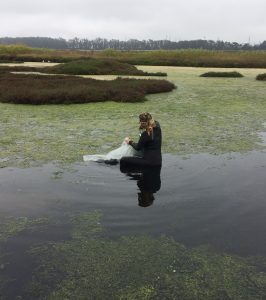Thesis Abstract

Nutrient Dynamics In Tidally Restricted Regions Of The Elkhorn Slough National Estuarine Research Reserve
By
Maureen M. Wise
Masters of Science in Marine Science
California State University Monterey Bay, 2017
The Elkhorn Slough, in the heart of the Monterey Bay, includes water bodies that have been isolated from natural tidal flushing cycles by dikes, levees, roads and train tracks. This partitioning has changed the functionality of these systems primarily through reduced circulation and increased eutrophication. The Elkhorn Slough is surrounded by a patchwork of lands under varied land-uses, including open space, developed properties, and extensive agriculture, which results in high and variable nutrient loading into the surrounding aquatic habitat. Water bodies of restricted flow disproportionately exhibit impacts due to this loading. In this study, nutrient concentrations were measured using both discrete water column sampling methods and in situ osmotic sampling techniques. Fluxes were measured using flow measurements, ground water flux correlations, benthic chambers, modeled pore water gradients and estimates of Ulva uptake. These measurements were used to quantify the cycling of nitrate, ammonium and phosphate in these pocket regions and has identified systemic nutrient drivers to be surface water flow, Ulva uptake and groundwater inputs. A box model approach was used to determine the degree to which these drivers contributed to overall nutrient concentrations on a seasonal timescale. The systems of study were all in dynamic disequilibrium, rather than steady-state. Nitrate varied from xx to yy on timescales as short as bb. Ammonium varied from ee to ff, and Phosphate varied from cc to dd on similar timescales. These variations were large compared to the same nutrients in the adjacent Elkhorn Slough. Such variability is significant when characterizing these systems, as it is indicative of the nature of nutrient flux in tidally restricted ecosystems and the rapid extremes in chemical composition experienced by the resident biota. The dominant sources of nutrients in these restricted areas also varied in time with surface runoff dominating in the wet season, and ground water inputs (possibly due to agricultural irrigation) dominating in the fall. Ulva uptake and advective flow were the largest loss terms and these too varied significantly in time. Understanding the key nutrient drivers, as well as the degree to which these drivers influence biogeochemical cycling of nutrients in these systems, informs mitigation projects as to how best manage estuarine regions with structural barriers inhibiting natural flow, a increasingly common feature of the coastal landscape.

